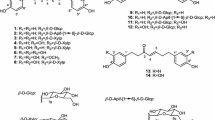Abstract
Bioassay directed fractionation of crude extract fromMahonia aquifolium led to the isolation of fraction A (bisbenzylisoquinoline alkaloid complex, BBI) and a fraction of protoberberine alkaloids, where the major compounds berberine and jatrorrhizine were isolated as their iodides. The antifungal activity of the crude extract, two protoberberine alkaloids and BBI fromM. aquifolium stem bark were evaluated against six strains ofMalassezia spp. The compounds tested were generally found to possess only weak to moderate antifungal properties: the MICs for individual strains were in the range ≤50–≥1000 mg/L.
Similar content being viewed by others
References
Anis K.V., Kuttan G., Kuttan R.: Role of berberine as an adjuvant response modifer during tumour therapy in mice.Pharm. Pharmacol. Commun. 5, 697–700 (1999).
Fukuda K., Hibiya Y., Mutoh M., Koshui, M., Akao S., Fujiwara H.: Inhibition of activator protein 1 activity by berberine in human hepatoma cells.Planta Med. 65, 381–383 (1999).
Guého E.: Malassezia. The new species and human diseases.J. Eur. Acad. Derm. Vener. 11, suppl. 2, S13 (1998).
Guého E., Midgley G., Guillot J.: GenusMalassezia with description of four new species.Antonie van Leeuwenhoek 69, 337–355 (1996).
Iwasa K., Kamigauchi M., Sugiura M., Nanba H.: Antimicrobial activity of some 13-alkyl substituted protoberberinium salts.Planta Med. 63, 196–198 (1997).
Iwasa K., Nanba H., Lee D.-U., Kang S.-I.: Structure-activity relationships of protoberberines having antimicrobial activity.Planta Med. 64, 748–751 (1998).
Kobayashi Y., Yamashita Y., Fuji N., Takaboshi K., Kawakami T., Kawamura M., Mizukami T., Nakano H.: Inhibitors of DNA topoisomerase I and II isolated from theCoptis rhizomes.Planta Med. 61, 414–418 (1995).
Okunade A.L., Hufford C.D., Richardson M.D., Peterson J.R., Clark A.M.: Antimicrobial properties of alkaloids fromXanthorhiza simplicissima.J. Pharm. Sci. 83, 404–406 (1984).
Otčenášek M. (Ed.):Examination Methods for Mycotic Diseases. (In Czech) Avicenum, Prague 1990.
Park K.-S., Kang K.-C., Kim J.-H., Adams D.J., Johng T.-N., Paik Y.-K.: Differential inhibitory effects of protoberberines on sterol and chitin biosynthesis inCandida albicans.J. Antimicrob. Chemother. 43, 667–674 (1999).
Sarma B.K., Pandey V.B., Mishra G.D., Singh U.P.: Antifungal activity of berberine iodide, a constituent ofFumaria indica.Folia Microbiol. 44, 164–166 (1999).
Schmeller T., Latz-Bruning, B., Wink M.: Biochemical activities of berberine, palmatine and sanguinarine mediating chemical defence against microorgamisms and herbivores.Phytochemistry 44, 257–266 (1997).
Sethi M.L.: Enzyme inhibition VI: inhibition of reverse transcriptase activity by protoberberine alkaloids and structure-activity relationships.J. Pharm. Sci. 72, 538–541 (1983).
Schmidt A., Rühl-Hörster B.:In vitro susceptibility ofMalassezia furfur against azole compounds.Mycoses 39, 309–312 (1996).
Slavík J., Bochořáková J., Košťálová D., Hrochová V.: Alkaloids ofMahonia aquifolium (Pursh) Nutt. II.Chem. Papers 39, 537–542 (1985).
Slobodníková L., Rasochová E., Košťálová D., Kotulová D., Sochorová R.: Bacterial colonization of skin lesis at pacients with acne and itsin vitro sensitivity to standardized extract fromMahonia aquifolium (Pursh) Nutt. (In Czech)Čes.-slov. Dermatol. 75, 99–103 (2000).
Strippoli V., Piacentini A., D'Auria F.D., Simonetti N.: Antifungal activity of ketoconazole and other azoles againstMalassezia furfurin vitro and invivo.Infection 25, 303–306 (1997).
Taira Z., Matsumoto M., Ishida S., Ichikawa T., Sakiya Y.: Aggregation of DNA enhanced by the protoberberine alkaloids coralyne and berberine.Chem. Pharm. Bull. 42, 1556–1561 (1994).
Urbášková P. (Ed.):Examination for Antimicrobial Therapy. (In Czech) Avicenum, Prague 1985.
Author information
Authors and Affiliations
Rights and permissions
About this article
Cite this article
Volleková, A., Košťálová, D. & Sochorová, R. Isoquinoline alkaloids fromMahonia aquifolium stem bark are active againstMalassezia spp.. Folia Microbiol 46, 107–111 (2001). https://doi.org/10.1007/BF02873586
Received:
Issue Date:
DOI: https://doi.org/10.1007/BF02873586




